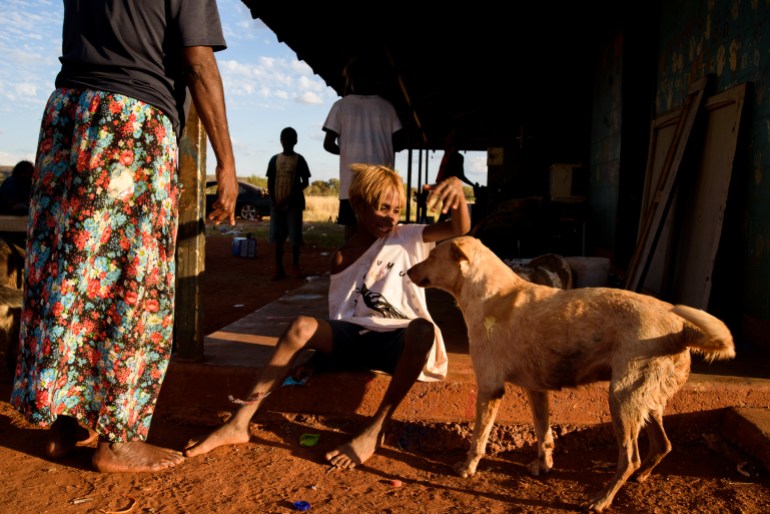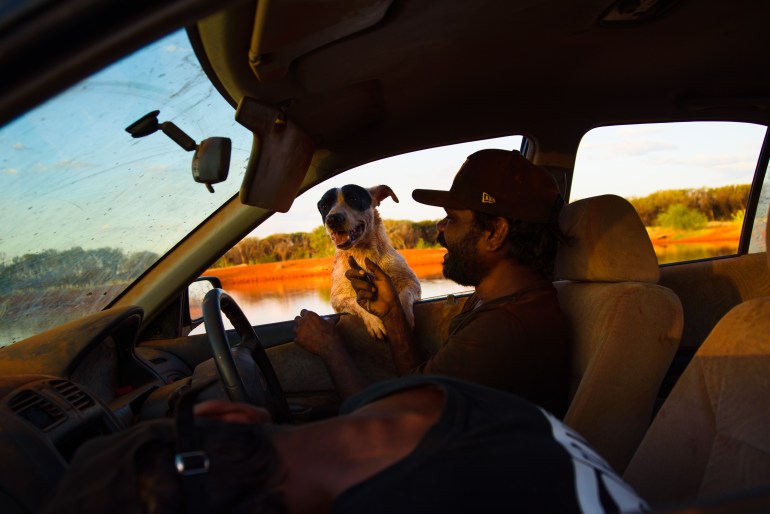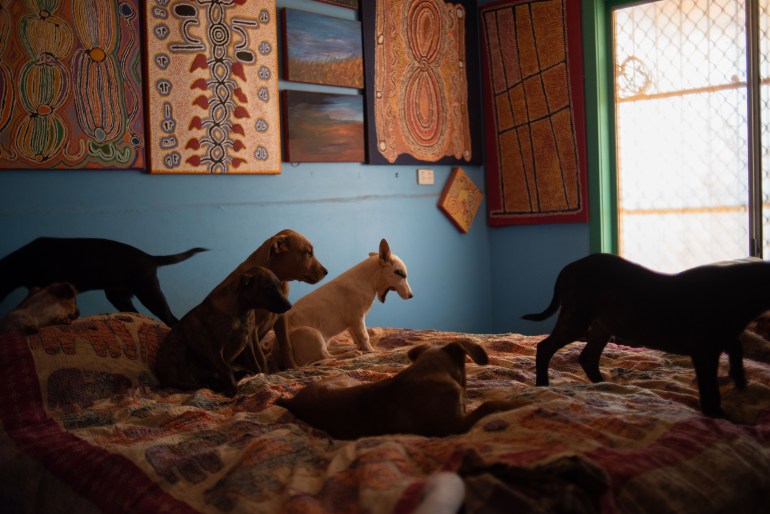Twenty years ago, when Gloria Morales arrived in Yuendumu, a remote community in Australia’s Northern Territory, “there were dead dogs everywhere”, she remembers.
An overpopulation crisis meant dogs were starving, sick, covered in mange. They were unvaccinated, malnourished, easily infected with bacteria, and their puppies were dying from infections. Many of the dogs were aggressive too, fighting and killing each other over territory and food. Like many of Australia’s remote Indigenous communities, Yuendumu had no vet and the nearest was located in Alice Springs, about 300km (186 miles) away.
It took Morales a long time to earn people’s trust. But over the past decades, she has led an extraordinary life in Yuendumu dedicated to the promotion of Indigenous arts and the transformation of the community’s dog population.
Dogs are particularly prominent in Aboriginal communities where dog ownership is much higher than the national average in Australia. According to one study, 65 percent of Aboriginal households claimed ownership of at least one dog.
While the “dingo” — a word derived from the Aboriginal Dharug language — arrived in Australia about 5000 years ago, domestic dogs came later with European colonisers. English botanist Joseph Banks first sailed into Botany Bay in 1770 with two greyhounds onboard.
Dingo burials found at archaeological sites give some insight into the long relationship between their contemporary half-wild descendants and Australia’s Indigenous communities.
In her observation of the relationship between the Warlpiri people in Yuendumu and their dogs, anthropologist Yasmine Musharbash writes of the role as akin to a family member and protector, “alerting a camp to the arrival of strangers, be they human or spirits”.
In Warlpiri folklore, it is their dogs who can sense and sniff out the presence of the Jarnpa, a type of invisible monster with superhuman strength and a taste for killing.

“Separate [Walpiri] people love dogs because they protect us. Keep us from being lonely. Dogs are like a shadow for Warlpiri people,” local artist Vanetta Nampijinpa Hudson told Al Jazeera.
Our dogs “follow us everywhere”, she says.
“Toilet and bathroom, everywhere!”
Dingoes and dogs
In Warlpiri rituals, stories and song lines, dogs and dingoes feature prominently.
The camp dogs that roam freely around Yuendumu are a result of dog and dingo interbreeding. To describe it as roaming might imply an aimlessness, whereas the dogs of Yuendumu trot with determination, seemingly always at attention and on the lookout. It is also not uncommon to see a member of the community trailed by a large pack of dogs.
“When white people come to Yuendumu they’re scared of all the dogs everywhere. They think those dogs are going to bite them,” Nampijinpa Hudson says.
“They don’t need to be scared because the dogs here aren’t too cheeky,” she says.
“That’s because they’re not hungry. Gloria [Morales] brings in food. In other communities those dogs can be really cheeky and crazy.”
![Trevor Jupurrurla Walker with his daughter and dog Creamy [Courtesy of Francis Macindoe/Warlukurlangu Artists]](https://www.aljazeera.com/wp-content/uploads/2023/04/Trevor-Jupurrurla-Walker-with-his-daughter-and-dog-Creamy-1-1682755680.jpg?w=770&resize=770%2C514)
Before moving to Yuendumu in 2003, Morales worked at the National Gallery in Canberra as a conservator of the Aboriginal collection. And though she came to take up a position as assistant manager of the local arts centre, it was Yuendumu’s dog problems that would consume her.
Initially, when she spoke about animal management, she was met with suspicion in the community. That might have been expected.
Morales grew up in the Chilean countryside of South America. But it was “very similar to this”, she says, gesturing to the red earth of the Australian outback.
Morales began talking to locals, building their trust over time.
“People were noticing that it wasn’t that I didn’t want the dogs, it was that I wanted to make them better,” she says.
“In the past, they were putting down the dogs that were easy to get to, the friendliest, the ones people wanted,” she recounts.
“I was told about a community manager who said, ‘Tie the dogs you don’t want to put down to a tree’”, she says. But “those were the dogs that were shot by the police”.
In consultation with the community, she began working with a vet to reduce the population, giving the dogs birth control implants and identifying those that were unwanted because they were aggressive, sick or suffering.
The dog lady of Yuendumu
“Healthy dogs mean healthy people”, so says the dog programme of Warlukurlangu Artists — one of Australia’s longest-running aboriginal-owned arts centres.
Morales established the programme in collaboration with the Warlukurlangu centre and later other organisations who assist with funding her work to care for the community’s dogs. It provides free dog food, health care, and regular vet visits. The programme’s success means that dogs are rarely euthanised.
Working with volunteers, Morales also established Aussie Desert Dogs, an adoption program which places local rescue dogs in homes throughout Australia.
Though organisations such as Animal Management in Rural and Remote Indigenous Communities deliver veterinary services to remote communities, injuries do not only happen when a vet comes to town, she says.

When she first arrived in the community, Morales tells how she was approached by an older woman who tentatively asked if she could have a look at her dog. The dog was salivating and could not eat. She put her hand in the dog’s mouth and pulled out a bone lodged in its jaw.
“And that was the solution,” she says.
And so, the visits began with people bringing their dogs for treatment. A woman whose dog had a bloody eyelid torn and flopping from a fight asked if she could stitch it up. With no surgical stitches on hand, Morales got some needles and thread.
“It worked!” she laughed, as though still surprised by her achievement. “People realised I was there to help them.”
Nowadays, she is known as the dog lady of Yuendumu and her home has become the local animal sanctuary.
At all hours of the day, people knock on her door with sick or wounded animals, not only dogs. Kangaroos, wild horses, snakes, turtles, birds, wedge-tail eagles, finches, and goannas (a species of lizard).
Lacking formal veterinarian training, Morales researches medical treatment for animals and sometimes talks through a difficult procedure with a vet via video calls.
Having a veterinary nurse working full-time in the community would be a better solution, she says, recounting how a few years before, a new deadly bacteria came into the community transmitted by tics.
“You need somebody going around to see which dogs need treatment,” she says.
‘No one else is going to do it’
Ever since she was a child, animals have been drawn to Morales. She shares a story of a neighbour’s dog in Chile who would see her coming home on the school bus and race over. The neighbour would say: “I know when Gloria is home because my dog isn’t, and he won’t come back until she leaves.”
Morales now shares her home with 47 dogs. It is well equipped with a large outdoor area where they can run, play and feed.
The most vulnerable ones, and those prone to being attacked by other dogs, can stay inside. One has breathing difficulty. Another is old and crippled after being run over multiple times. The one with a brain tumour, whose face is distorted, sleeps on her bed.
“He eats all his food and he’s happy to see me,” she says of the dog. “I talk to him. He’ll let me know when he doesn’t want to live any more.”

Then there is the paralysed dog who she takes for walks in a wheelchair. In her bathroom, a dog with brain damage walks in circles, with a couple of puppies to keep him company. The other puppies cause havoc in the house. They poop everywhere and chew everything.
Getting back from work, Morales assesses the damage: “What did they destroy today?
After her work is done each night, Gloria tosses vegetables and chicken into a giant pot. She then adds rice the next morning so the dogs have a cooled, cooked meal when she gets home. She does not sleep much, and her arms have scars from dog bites over the years.
“I just go to the clinic and get antibiotics,” she says of those injuries.
Does she ever ask herself why she does it? Are the dogs of Yuendumu worth it?
“I don’t go ‘oh my god I’m so tired’ or whatever,” she says.
“It just needs to be done and no one else is going to do it.”


